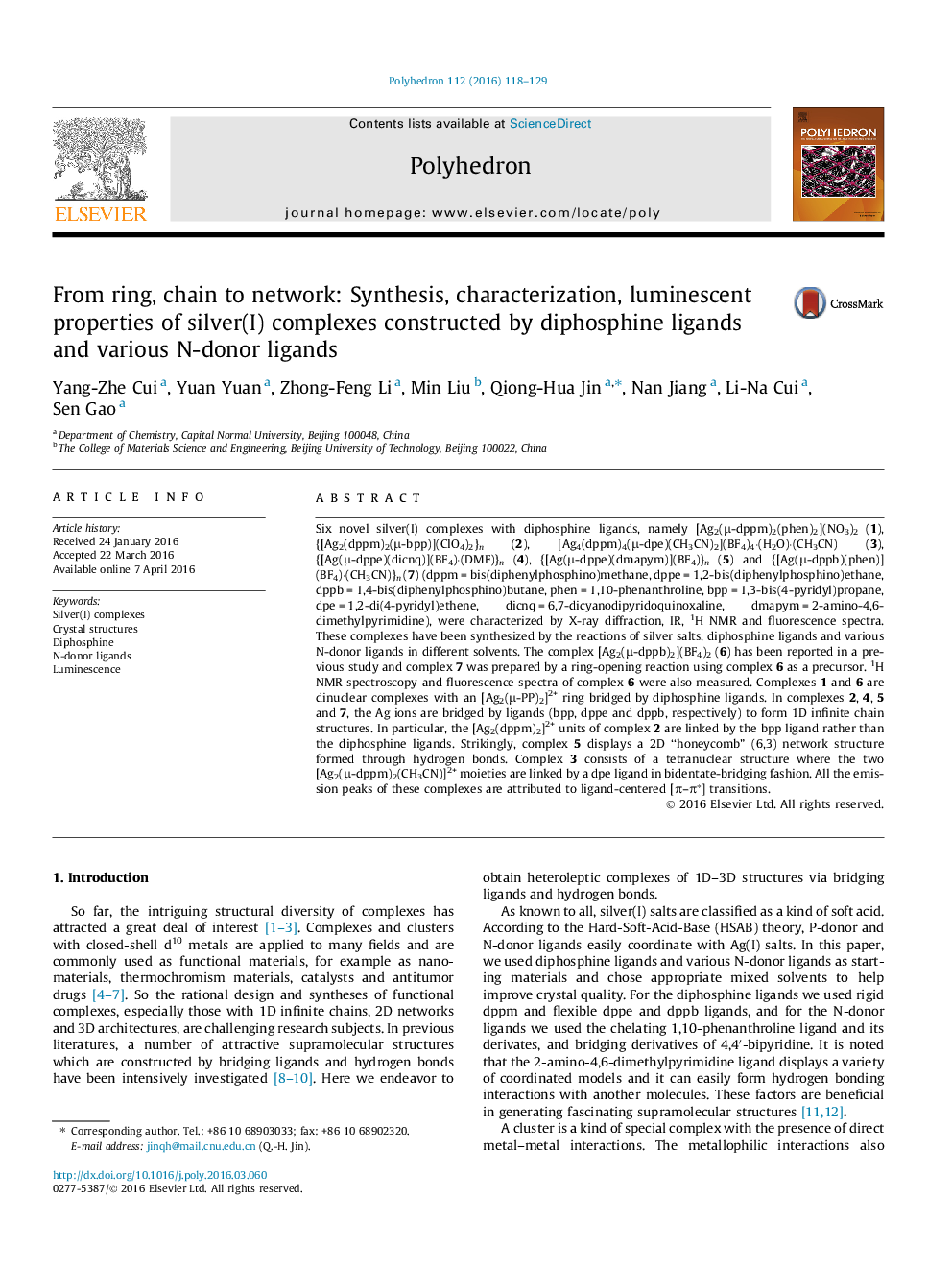| کد مقاله | کد نشریه | سال انتشار | مقاله انگلیسی | نسخه تمام متن |
|---|---|---|---|---|
| 1335079 | 1500228 | 2016 | 12 صفحه PDF | دانلود رایگان |

Six novel silver(I) complexes with diphosphine ligands, namely [Ag2(μ-dppm)2(phen)2](NO3)2 (1), {[Ag2(dppm)2(μ-bpp)](ClO4)2}n (2), [Ag4(dppm)4(μ-dpe)(CH3CN)2](BF4)4·(H2O)·(CH3CN) (3), {[Ag(μ-dppe)(dicnq)](BF4)·(DMF)}n (4), {[Ag(μ-dppe)(dmapym)](BF4)}n (5) and {[Ag(μ-dppb)(phen)](BF4)·(CH3CN)}n (7) (dppm = bis(diphenylphosphino)methane, dppe = 1,2-bis(diphenylphosphino)ethane, dppb = 1,4-bis(diphenylphosphino)butane, phen = 1,10-phenanthroline, bpp = 1,3-bis(4-pyridyl)propane, dpe = 1,2-di(4-pyridyl)ethene, dicnq = 6,7-dicyanodipyridoquinoxaline, dmapym = 2-amino-4,6-dimethylpyrimidine), were characterized by X-ray diffraction, IR, 1H NMR and fluorescence spectra. These complexes have been synthesized by the reactions of silver salts, diphosphine ligands and various N-donor ligands in different solvents. The complex [Ag2(μ-dppb)2](BF4)2 (6) has been reported in a previous study and complex 7 was prepared by a ring-opening reaction using complex 6 as a precursor. 1H NMR spectroscopy and fluorescence spectra of complex 6 were also measured. Complexes 1 and 6 are dinuclear complexes with an [Ag2(μ-PP)2]2+ ring bridged by diphosphine ligands. In complexes 2, 4, 5 and 7, the Ag ions are bridged by ligands (bpp, dppe and dppb, respectively) to form 1D infinite chain structures. In particular, the [Ag2(dppm)2]2+ units of complex 2 are linked by the bpp ligand rather than the diphosphine ligands. Strikingly, complex 5 displays a 2D “honeycomb” (6,3) network structure formed through hydrogen bonds. Complex 3 consists of a tetranuclear structure where the two [Ag2(μ-dppm)2(CH3CN)]2+ moieties are linked by a dpe ligand in bidentate-bridging fashion. All the emission peaks of these complexes are attributed to ligand-centered [π–π∗] transitions.
Complexes 1–7, containing diphosphine ligands, were synthesized and characterized by X-ray diffraction, IR, 1H NMR and fluorescence spectra. Strikingly, complex 5 displays a 2D architecture through hydrogen bonds to form a “honeycomb” (6,3) network structure. Complex 7 is prepared by the ring-opening reaction of complex 6.Figure optionsDownload as PowerPoint slide
Journal: Polyhedron - Volume 112, 7 July 2016, Pages 118–129